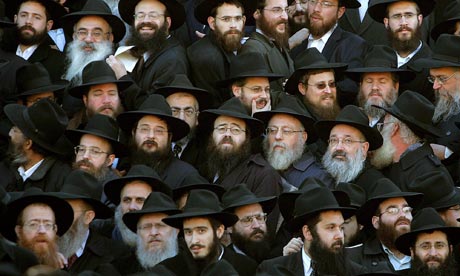Religious and civic leaders work hard to maintain mutual respect and equal rights in this New York
Lubavitch rabbis, clad in traditional Hassidic garb, line up outside their worldwide headquarters in the Brooklyn borough of New York City
The man at the till is wearing phylacteries (amulets) under his shirt. Abundant payot – the sidelocks worn by Orthodox Jews from eastern Europe – spill out from under his black kippa. Some of the waiters are also Jewish, but others are Latinos. But the cooks are all Orthodox Jews. The food, a mixture of central European and Middle Eastern dishes, is strictly kosher. What is more surprising is the clientele: Jews rub shoulders with Muslims who choose to eat here because the food is good value and kosher, and thus close to halal standards set by Islam.
The Famous Pita restaurant, on Coney Island Avenue Brooklyn borough where Jews and Muslims live side by side. On several blocks the co-existence of the two communities is even more apparent, with a succession of synagogues, mosques and social centres. Usually, however, the two communities live apart, with ultra-Orthodox Jews sticking to their own neighbourhoods, and Muslims, who are relative newcomers, more dispersed. In keeping with tradition, they tend to gather in specific districts.
The co-existence in Brooklyn is noteworthy for several reasons. Terrorist attacks by Muslims resident in the US Brooklyn (2.6 million) has the world's second-largest Jewish and Muslim population, after Jerusalem US Brooklyn , almost half of whom are ultra-Orthodox. Between 200,000 and 300,000 Muslims, mainly from the Indian subcontinent, live here too. They form the second-largest group of recent immigrants, after Hispanics, and their number is growing steadily, unlike the dwindling Jewish community. Jews and Muslims make up a third of the borough's residents.
So how do they get on, particularly as various external factors – not least the Middle East conflict – supposedly fuel mutual distrust? The Jews have been here since the 19th century, whereas the Muslims arrived more recently. And the prevailing mood in the US
The Israeli-Palestinian conflict seems remote. The overall priority, from the White House down to community groups, is to prevent any flare-ups. Certainly "some mosques are closely watched by the FBI, which we know also protects Jewish centres more closely", a Muslim leader admits. In 2007 several Jewish pressure groups were active in opposing the opening of an Anglo-Arabic school. In November 2006 five Jewish youths yelling "Muslim terrorists" beat up a young Pakistani. He needed reconstructive facial surgery. The following year a group of Muslims seriously assaulted a rabbi.
But such acts are mercifully rare and the authorities are careful not to overplay their importance. Marty Markowitz, the borough president since 2002, has taken the same line as his predecessor Howard Golden. Both are Jewish and have allocated substantial funds to fostering Jewish-Muslim dialogue and Muslim empowerment. "Dialogue between Jews and Muslims is often non-existent because of Israel
"I see more and more Muslims taking part in social life. The future is looking good." He highlights one surprising point, particularly for a non-practising Jew: "Mutual respect is easier to achieve between believers than with the others." He reckons that among those who believe in a single deity, "no one will be shocked by a woman wearing a burka or a man in a Schtreimel hat and a frock coat".
Some Muslims, faced with a fairly hostile environment, fall back onreligion, but most are escaping from the closed world they left behind. Mohammad Razvi arrived here from Pakistan Brooklyn barber's shop. A sign in the window reads: "Hindi, Yiddish and Punjabi spoken." He sees this as a symbol of what he wants to achieve. "When we heard about the attempted attack on two synagogues by radical Muslims, I was the first to call for a march. The rabbis Robert Kaplan and Michael Miller immediately endorsed the idea," Razvi says. The two rabbis head theJewish Community Relations Council. "It made sense: when Jewish youths attacked a Muslim child, the rabbis were also the first to protest," Razvi adds.
At Eichlers, the World's Judaica Store, the manager Moshe Perl has a ready-made explanation: "God tells me to love my neighbour as myself. Fortunately for me, it is a lot easier here than in the Middle East ."
This article originally appeared in Le Monde

